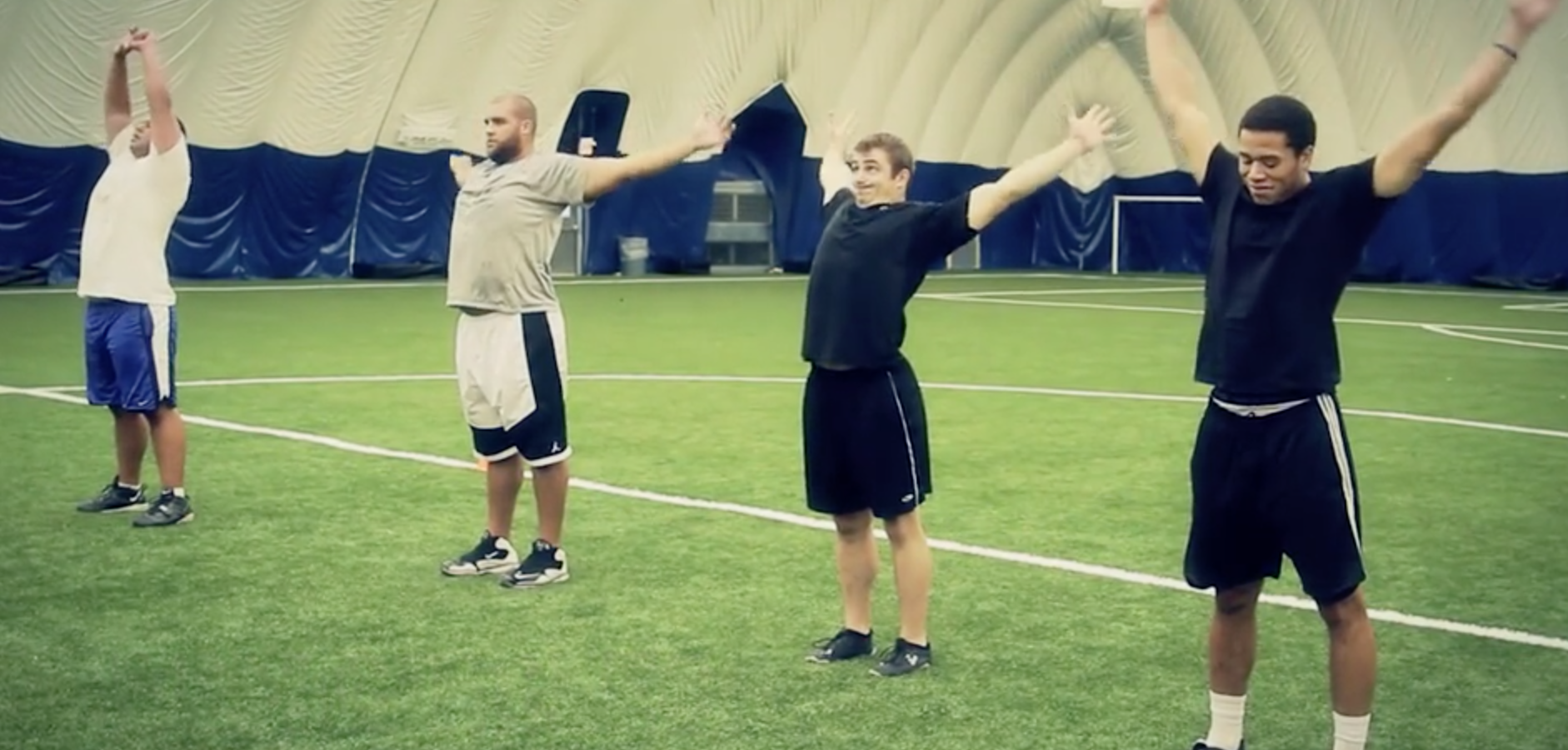4 Steps to an Effective Warm-up Routine
By: Brad Walker

Warm-up properly with these 4 steps and reduce your risk of injury!
Warm-up activities are a crucial part of any exercise regimen or sports training. The importance of a structured warm-up routine should not be underestimated when it comes to the prevention of sports injury.
An effective warm-up has a number of key elements or steps. These elements should all be working together to minimize the likelihood of sports injury from physical activity. The main purpose of warming up is to prepare the body and mind for more strenuous activity. One of the ways an effective warm-up achieves this is by helping to increase the body's core temperature, while also increasing the body's muscle temperature, helping to make the muscles loose, supple and pliable.
An effective warm-up also has the effect of increasing both heart and respiratory rate, thereby increasing blood flow. Increased blood flow increases the delivery of oxygen and nutrients, helping to prepare the soft tissues for more strenuous activity.
Keeping in mind the aims or goals of an effective warm-up, we can then go on to look at how the warm-up should be structured. But before we do…
What has Science got to say?
Currently, there seems to be a lot of confusion about how and when stretching should be used as part of the warm-up, and some people are under the impression that stretching should be avoided altogether. This is a very important issue and needs to be clarified immediately.
Most studies attempt to determine the effects of stretching on injury prevention. This is a mistake in itself and shows a lack of understanding as to how stretching is used as part of an injury prevention program and the warm-up.
Stretching and its effect on physical performance and injury prevention is something that just can't be measured scientifically. Sure you can measure the effect of stretching on flexibility with simple tests like the "Sit and Reach" test, but then to determine how that affects athletic performance or injury susceptibility is nearly impossible.
One of the more recent studies on stretching supports this view by concluding;
"Due to the paucity, heterogeneity and poor quality of the available studies no definitive conclusions can be drawn as to the value of stretching for reducing the risk of exercise-related injury." (The efficacy of stretching for prevention of exercise-related injury: a systematic review of the literature, 2003, Weldon) To put the above quote in layman's terms; there haven't been enough studies done and the studies that have been done are not specific or consistent enough.
The Greatest Misconception
Confusion about what stretching accomplishes, as part of the warm-up, is causing many to abandon stretching altogether. The key to understanding the role stretching plays can be found in the previous sentence. But, you have to read it carefully. Stretching, as part of the warm-up!
Here's the key: Stretching is a critical part of the warm-up, but stretching is NOT the warm-up.
So what conclusions can we make?
Stretching is beneficial, when used correctly. However, as with most activities there are rules and guidelines to ensure that they are safe, and stretching is no exception.
Remember, stretching is just one very important component that assists to reduce the risk of injury and improve athletic performance. The best results are achieved when stretching is used in combination with other injury reduction techniques and conditioning exercises. Stretching is one of the most under-utilized techniques for improving athletic performance, preventing sports injury and properly rehabilitating sprain and strain injury.
Don't make the mistake of thinking that something as simple as stretching won't be effective.
So, how do you incorporate the right type of stretching into your warm-up routine?
4 Steps to an Effective Warm-up routine
Obviously, it's important to start with the easiest and most gentle activity first, building upon each part with more energetic activities, until the body is at a physical and mental peak. This is the state in which the body is most prepared for the physical activity to come, and where the likelihood of sports injury has been minimized. So, how should you structure your warm-up to a ieve these goals?
There are 4 key elements that should be included to ensure an effective and complete warm-up routine. All 4 steps are equally important and no one step should be neglected. All 4 elements work together to bring the body and mind to a physical peak, ensuring the athlete is prepared for the activity to come and reducing the risk of injury. Let’s have a look at each step individually.
1.) General warm-up
The general warm-up should consist of a light physical activity. Both the intensity and duration of the general warm-up (or how hard and how long), should be governed by the fitness level of the participating athlete. A correct general warm-up for the average person should take about five to ten minutes and result in a light sweat.
The aim of the general warm-up is simply to elevate the heart and respiratory rate. This in turn increases the blood flow and helps with the transportation of oxygen and nutrients to the working muscles. This also helps to increase the muscle temperature, allowing for a more effective static stretch in the next step.
2.) Static stretching
Static stretching is a very safe and effective form of stretching. There is a limited threat of injury and it is extremely beneficial for overall flexibility. During this part of the warm-up, gentle static stretching should include all the major muscle groups, and this entire part should last for about five to ten minutes.
Static stretching is performed by placing the body into a position whereby the muscle; or group of muscles to be stretched is under tension. Both the opposing muscle group (the muscles behind or in front of the stretched muscle), and the muscles to be stretched are relaxed. Then slowly and cautiously the body is moved to increase the tension of the muscle, or group of muscles to be stretched. At this point the position is held or maintained to allow the muscles and associated soft tissue to lengthen.
This second part of an effective warm-up is extremely important in the prevention of muscle and tendon injuries, as it helps to lengthen both the muscles and tendons, which in turn allow your limbs a greater range of movement.
The above two steps form the foundation for a complete and effective warm-up. It is extremely important that these two elements be completed properly before moving on to the next two elements. The proper completion of elements one and two, will allow for the more specific and vigorous activities necessary for elements three and four.
3.) Sport specific warm-up
In this part, the athlete is specifically preparing their body for the demands of their particular sport. During this part of the warm-up, more vigorous activity should be employed. Activities should reflect the type of movements and actions that will be required during the sporting event.
4.) Dynamic stretching
Finally, a correct warm-up should finish with a series of dynamic stretches. However, this form of stretching carries with it an increased risk of injury if used incorrectly.
Dynamic stretching involves a controlled, soft bounce or swinging motion to force a particular body part past its usual range of movement. The force of the bounce or swing is gradually increased but should never become radical or uncontrolled.
Dynamic stretching is just as useful for muscular conditioning as it is for flexibility, and is best suited for well trained athletes. Dynamic stretching should be incorporated after a high level of general flexibility has been established.
During this last part of an effective warm-up it is also important to keep the dynamic stretches specific to the athlete’s particular sport. This is the final part of the warm-up and should result in the athlete reaching a physical and mental peak. At this point the athlete is most prepared for the rigors of their sport or activity.
The above information forms the basis of a complete and effective warm-up. However, I am well aware that this entire process is somewhat of an 'ideal' or 'perfect' warm-up. I am also well aware that this is not always possible; or convenient in the real world.
Therefore, the individual athlete must become responsible for assessing their own goals and adjusting their warm-up accordingly.
For instance, the time you commit to your warm-up should be relative to your level of involvement in your particular sport. So for people just looking to increase their general level of health and fitness, a minimum of five to ten minutes would be enough. However, if you are involved in high level competitive sport you need to dedicate adequate time and effort to a complete warm-up.
Conclusion
As you can see, an effective warm-up involves more than just a few laps around the track, or a leisurely swim up and down the pool. The importance of a structured warm-up routine should not be underestimated when it comes to the prevention of sports injury. So get serious about your warm-up and apply these 4 steps to reduce your risk of injury and improve your athletic performance.
Recommended Athletes' Acceleration
Products
—————————————————————————–
About the Author:
Brad Walker is a leading stretching and sports injury consultant with nearly 20 years experience in the health and fitness industry. For more articles on stretching, flexibility and sports injury, visit TheStretchingInstitute.com.




0 Comments for “4 Steps to an Effective Warm-up Routine”